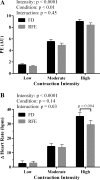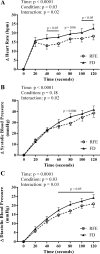Cardiovascular responses during isometric exercise following lengthening and shortening contractions
- PMID: 30382808
- PMCID: PMC6397412
- DOI: 10.1152/japplphysiol.00601.2018
Cardiovascular responses during isometric exercise following lengthening and shortening contractions
Abstract
The present study investigated the effects of prior lengthening or shortening contractions on cardiovascular responses during isometric exercise. We utilized the history dependence of skeletal muscle, where active 2-s lengthening or shortening before an isometric contraction can increase [residual force enhancement (RFE)] or decrease [force depression (FD)] force production. Matching torque output between RFE and FD conditions yields lower and higher electromyography (EMG) values, respectively. In study 1, heart rate and perceived exertion (PE; Borg10) were measured in 20 participants during 20-s isometric plantar flexion contractions at low (16 ± 4% MVC)-, moderate (50 ± 5% MVC)-, and high (88 ± 7% MVC)-intensity. In study 2, heart rate and blood pressure were measured in 14 participants during 2-min isometric plantar flexion contractions (40% MVC). In both studies, torque output was held constant between FD and RFE conditions resulting in differences in soleus EMG activity ( P < 0.05). In study 1, PE was lower during the RFE condition ( P < 0.01), while increases in heart rate were similar between FD and RFE at low (∆2 ± 8 vs. 3 ± 6 beats/min, P > 0.99) and moderate (∆14 ± 9 vs. 14 ± 9 beats/min, P > 0.99) intensity but smaller during RFE at high intensity (∆35 ± 13 vs. 29 ± 13 beats/min, P = 0.004). In study 2, heart rate responses were smaller in the RFE condition following the initial 20-s period; diastolic blood pressure responses were smaller during the last 80 s. A 2-s active change in muscle length before an isometric contraction can influence heart rate and blood pressure responses; however, these differences appear to be modulated by both intensity and duration of the contraction. NEW & NOTEWORTHY Using the history dependence of isometric force to alter maximal torque production and motor unit activation between residual force enhancement and force depression conditions, we observed that heart rate responses were different between conditions during a subsequent 20-s high-, but not low- or moderate-, intensity isometric contraction. A 2-min moderate-intensity contraction revealed time-dependent effects on heart rate and diastolic blood pressure. Active 2-s shortening and lengthening before an isometric contraction can influence the cardiovascular responses.
Keywords: blood pressure; exercise; heart rate; history dependence of force; isometric.
Conflict of interest statement
No conflicts of interest, financial or otherwise, are declared by the authors.
Figures




References
-
- Amann M, Proctor LT, Sebranek JJ, Eldridge MW, Pegelow DF, Dempsey JA. Somatosensory feedback from the limbs exerts inhibitory influences on central neural drive during whole body endurance exercise. J Appl Physiol (1985) 105: 1714–1724, 2008. doi:10.1152/japplphysiol.90456.2008. - DOI - PMC - PubMed
Publication types
MeSH terms
LinkOut - more resources
Full Text Sources
Medical

